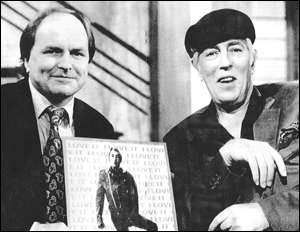|
In 1988 a London local radio station, LBC, began
receiving some rather strange calls to one it's phone-in shows.
The programme was hosted by Clive Bull and went out, unheard by
most of the world, between four and six o'clock in the morning and
the caller was Sven, a Norwegian fisherman living in Swiss
Cottage whose twin obsessions were fish and Jutte, his estranged
girlfriend. Sven was, in fact, Cook. Quite why he thought it amusing
to call an obscure radio show anonymously at a time when virtually
no-one would have heard him is a mystery Cook took with him to the
grave - a cry for help, a way of communicating his inner most thoughts
on the only platform he knew, the media, or something to do for
a laugh when he was a bit pissed? [See also P&B #12
& 13]. The calls went
on, on and off, for the next four years and marked a different era
for Cook, a more introspective one, where comic displays were mainly
reserved for friends and visitors to his house in Perrins Walk and,
from now until his death, he only embarked on four major new creative
public projects.
He carried on supplying small, undemanding film
roles such as Getting It Right (1989), a diverting romantic
comedy, and Great Balls Of Fire! (1989), a biopic of Jerry
Lee Lewis with Cook as troublesome journalist. Cook did, however,
manage to re-unite with Moore for a few brief appearances. They
had appeared together in the 1987 American version of Comic Relief,
performing One Leg Too Few once again, and then again in
London in the 1989 Amnesty show The Secret Policeman's Biggest
Ball, with One Leg Too Few again and an old Sir Arthur
Streeb-Greebling sketch, The Frog And Peach, as well as appearing
on television together in an interview with Mavis Nicholson
(1989 ITV). The re-union was largely engineered by Cook's girlfriend
Lin Chong, who he had known since 1982. Cook's marriage to Judy
had broken down in the early '80s, although they remained in contact
and friends. He finally divorced Judy in 1989 and married Lin in
the same year.
In 1990 Cook and Moore got together again to assemble
The Best Of What's Left Of Not Only... But Also video (1990
BBC Enterprises, re-released in 1999 as Comedy Greats: Peter
Cook and Dudley Moore). The debacle of the BBC's destruction
of many of the original Not Only... But Also tapes is well
documented at the Some
Of The Corpses Are Amusing site (under Edit News), but sufficient
material was found to make a video of the best bits left and to
compile a series of six half-hour shows under the same title as
the video (1990 BBC2) and which featured much material that didn't
make it on to video. At the time of writing, the BBC are considering
plans to release this material as well as other bits and bobs in
the vaults. Phone them up today as ask where the fuck it is, and
then phone them up again tomorrow.
Cook was also persuaded to dust off one of his oldest
characters, Sir Arthur Streeb-Greebling for a new television series.
A Life In Pieces (December 1990-January 1991 BBC2) was a
series of twelve five-minute shows where Sir Arthur would be interviewed
by Ludovic Kennedy around the theme of the carol The Twelve Days
Of Christmas. The programmes were aired late at night and scheduling
problems meant it was broadcast at different times each night, and
the programme was almost completely ignored. Although the scripts
themselves were first-rate [see
P&B #15 onwards], and the first new material written
for Sir Arthur since the 1971 Not Only.. But Also Australian
specials, something was lost in the transference to television and
the series failed to re-spark interest in Cook as a writer/performer.
Cook made a few more television appearances over
the next couple of years, mainly in other people's scripts, such
as Whose Line Is It Anyway (1988 Channel 4), the one-off
The Craig Ferguson Story (1991 Channel 4) as Ferguson's father,
the comedy drama series Gone To Seed (1992 ITV) as a conman,
and One Foot In The Algarve (1993 BBC1), the One Foot
In The Grave Christmas special, as a photographer. He also did
a host of voiceovers, including Roger Mellie, The Man On The
Telly (1991 Channel 4), the cartoon version of the Viz comic
strip, and the voice of Radio of an Arena special Radio Night
(1993 BBC2 & Radio 4), as well as guest appearances on such
shows as Have I Got News For You, twice (1991 and 1993 BBC2),
Fantasy Football League (1994 BBC2) and Room 101 (1994
BBC2). In addition there was a creditable appearance as an aristocrat
in a film of Black Beauty (1994) with Eleanor Bron. These
brought in some income, helping to fund Cook's self-imposed semi-retirement,
along with some spoof sports columns for the London Evening Standard
and, of course, his continued contributions to Private Eye which
had sustained him creatively since the 1960s.
But Cook was obviously keen to show he could still
write and perform, as he demonstrated in blistering form on a special
edition of Clive Anderson Talks Back (1993 Channel 4), dedicated
to four Cook characters being interviewed by Anderson. The resulting
Christmas special was quite simply one of the best pieces of television
work Cook ever did, with characterisation, performance and quality
gags all in perfect harmony. Two of the characters were essentially
old ones spruced up, Norman House, a biscuit tester kidnapped by
aliens, was E.L. Wisty in a comfy jumper, and the judge Sir James
Beauchamp was Sir Arthur Streeb-Greebling's fascist older brother.
These were complemented by two new characters, Alan Latchley, every
terrible football manager rolled into one, and ageing supergroup
rock star Eric Daley [See P&B
#19].
After the Clive Anderson show, the public, for a
brief period, sat up and noticed Cook again. He seemed to be back
to something of his old self, and the success of his next project,
Why Bother? (1994 BBC Radio 3), brought him more attention.
As in A Life In Pieces, Why Bother? was a set of interviews
with Sir Arthur Streeb-Greebling, this time with Chris Morris in
the chair. But the new show attempted to circumvent the problems
of A Life... by being largely improvised rather than scripted,
capturing Cook's flights of fancy perfectly as they emerged rather
than flattened by over-rehearsal. The use of radio rather than television
allowed Cook to explore stranger and stranger avenues, flipping
between word-play, mental cartoons and surreal yet semi-autobiographical
ramblings. Morris himself proved a tough questioner, employing his
then-trademark Paxman-esque aggressive style which, rather than
brow-beating Cook brought out the best in him [See
P&B #13].
It was to prove, however, Cook's last great creative
spurt. A second series of A Life In Pieces was commissioned
but never made and his last work as a writer/performer was a rather
disappointing video, Peter Cook Talks Golf Balls (1994).
Intended to build on the success of the Clive Anderson show, Cook
adopted four different characters including a Major Titherly Glibble,
another Streeb-Greebling clone [See
P&B #12]. The results did not match those of the
Clive Anderson show and interest receded.
On the 9th of January 1995 Peter Cook died in the
Royal Free Hospital as the result of a gastro-intestinal haemorrhage.
further
reading
|


